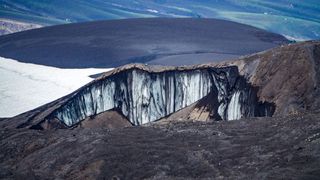
Thawing permafrost due to climate change is releasing methane, a potent greenhouse gas.
(Image credit: Valerii Buzun via Getty Images)
Deep beneath the permafrost that blankets a group of islands in the Arctic Ocean lurks a growing and migrating sea of methane, researchers have discovered.
The thick permafrost, or ground that remains frozen for at least two years, forms a tight seal that has so far prevented millions of cubic feet of methane from wafting out — but there’s no guarantee that the potent greenhouse gas won’t eventually escape, according to a study published Dec. 13 in the journal Frontiers in Earth Science.
“At present, the leakage from below permafrost is very low, but factors such as glacial retreat and permafrost thawing may ‘lift the lid’ on this in the future,” lead author Thomas Birchall, a geologist at the University Center in Svalbard in Norway, said in a statement.
The base of permafrost is undulating, which creates pockets between the permafrost and the underlying geology where gas from biological and non-biological sources can accumulate and become trapped. Should this permafrost seal disintegrate, it could set off a chain reaction in which the methane’s strong warming effect would thaw more permafrost and release even more gas. This vicious feedback loop would further accelerate warming, melting and methane emissions, the researchers warned in the study.
Related: The ozone hole above Antarctica has grown to three times the size of Brazil
Permafrost is widespread on Svalbard, a Norwegian archipelago located deep inside the Arctic Circle and just 500 miles (800 kilometers) from the North Pole. Missions that involve drilling into the frozen soil in search of fossil fuels often hit pockets of natural gas by accident, but the extent of these reserves was unknown, according to the study.
Birchall and his colleagues used historical data from commercial and scientific boreholes to map the permafrost throughout Svalbard and pinpoint these stores of natural gas. The researchers found deposits rich in methane are much more common than thought on the islands. Given that the archipelago has a similar geological and glacial history to the rest of the Arctic region, the same could be true of other permafrost-covered locations near the North Pole, the statement said.
The permafrost seal on Svalbard isn’t uniform, the study found. Coastal areas had a thinner crust of frozen soil due to the warmth brought by ocean currents, whereas permafrost in the lowlands was thick and saturated with ice, meaning it has “extremely good sealing properties” and is able to “self-heal,” the researchers wrote in the study. In the highlands, the permafrost was flakier and more permeable due to dry conditions.

Low tide on Spitsbergen, the largest and only permanently populated island of the Svalbard archipelago. (Image credit: Patricia Hamilton via Getty Images)
But permafrost that is leak-proof now might not stay that way. Svalbard is one of the fastest warming places on the planet, according to the study, and its “active” layer of permafrost — the upper few feet that thaw and refreeze seasonally — grows deeper as global temperatures rise.
Estimating how much methane is trapped below the permafrost is tricky, because it is difficult to access and there are only a few dozen boreholes on which to draw conclusions. Based on one location where the flow of gas was measured, however, the researchers estimate it could be in the order of several million cubic feet.
“With permafrost thawing in the Arctic, there is a risk that the impacts of releasing methane trapped beneath permafrost will lead to positive climatic feedback effects,” they wrote in the study.
Join our Space Forums to keep talking space on the latest missions, night sky and more! And if you have a news tip, correction or comment, let us know at: [email protected].
Breaking space news, the latest updates on rocket launches, skywatching events and more!
Sascha is a U.K.-based trainee staff writer at Live Science. She holds a bachelor’s degree in biology from the University of Southampton in England and a master’s degree in science communication from Imperial College London. Her work has appeared in The Guardian and the health website Zoe. Besides writing, she enjoys playing tennis, bread-making and browsing second-hand shops for hidden gems.
>>> Read full article>>>
Copyright for syndicated content belongs to the linked Source : Space.com – https://www.space.com/methane-beneath-arctic-permafrost-climate-feedback-loop































